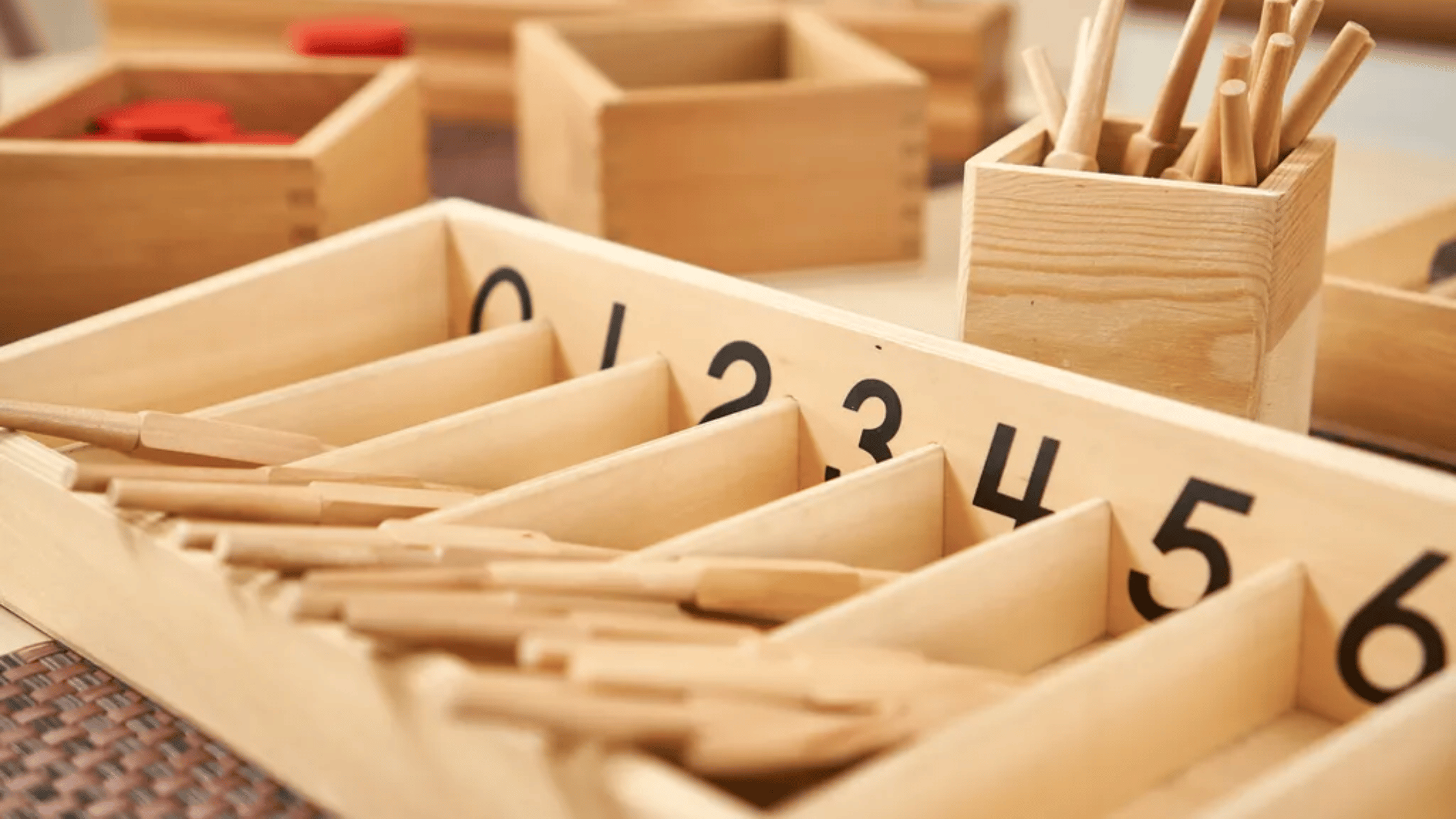If you want to about Montessori spindle boxes and are curious to know about how they are taught in classrooms. Well you’re in the right place.
Montessori spindle box is a Montessori Math material to introduce the child to counting and the concept of zero. It is introduced in the primary level classrooms i.e. for children aged 3–6 years.
Let’s start without further ado.
What is Montessori Spindle Box?
The Montessori spindle box is an educational tool used in Montessori classrooms to teach children counting and numerical concepts. It consists of two wooden boxes with compartments numbered from 0 to 4 & 5 to 9 and a set of 45 wooden spindles or rods. See the image below.
By using the spindles, children can easily grasp the idea of quantity and numerical order as they accurately place the appropriate number of spindles in each compartment while counting them. It’s a hands-on, tactile approach to early math education in the Montessori method.
What is the Purpose of Spindle Boxes?
The main purpose of the Montessori spindle box is to introduce children to the concept of zero, quantity and numerical order in a hands-on and visual way. It helps them develop counting skills, understand the numerical value of each digit, and practice one-to-one correspondence, where each object corresponds to a number. Through this activity, children lay the foundation for more advanced math concepts.
What are the Materials Required for Spindle Box Activity?
- Montessori spindle boxes with compartment
- 45 spindles
How to Use Spindle Box to Introduce Children with Numbers?
In order to use and learn a spindle box, follow the below steps:
- Invite the child to the working area and introduce them with the spindle box.
- Show them this is spindle box and is divided into 10 different empty spaces and long sticks are called spindles.
- Tell them today we will learn about quantities and introduce them with numbers.
- First, start introducing the child to the numbers starting with 1, followed by 2 and so on.
- Now ask the child to count and match the spindles with the numbers written in compartments.
- Ask them to put the counted spindles in each compartment. It will be line compartment written 1 will have one spindle, 2 will have 2 spindles and so on.
- Once the child places all the spindles till 9th compartment. Ask them to bind the spindles respectively. At the end, there will be no spindle left.
- Now tell child, since there is no spindle left. Therefore, we will not put anything in compartment with ‘0’. As ‘0’ means nothing.
- Encourage the child to practice putting the spindles in and taking them out.
- Praise the child for their efforts.
Extension of Spindle Box Activity
Montessori materials can be used in many ways. Therefore, we can make a lot of extentions/variations of each activity.
- Once the child has mastered putting the spindles in and taking them out, you can challenge them to put them in a certain order or to put them in a specific pattern.
Control of Error in the Spindle Box
No or any leftover spindles at the end serves as a self-correction mechanism for this activity. If any spindles are leftover or missing, it indicates an error that the child should identify and correct. The facilitator underscores the significance of ‘zero’ as a placeholder, signifying ‘nothing’ until it reaches the number 10.
Additionally, this lesson can help children develop their sense of order and organization. It can also help them learn about cause and effect. For example, if the child puts the spindle in the wrong hole, it will not fit, and they will have to take it out and try again. This can help them learn that their actions have consequences.
After accurately counting and placing spindles in the compartments, the child is instructed to return each spindle individually to its designated wooden box.
What is the Purpose of Binding the Spindles?
Binding the spindles together aids the child in acquiring a physical sense of quantity, enhancing their listening abilities, and fostering an understanding of numerical sets. Additionally, it offers the child more opportunities to associate each number with its corresponding quantity.
Here are some additional tips for teaching this lesson:
- Make sure the spindles are the right size for the child’s hands.
- Be patient and encouraging as the child learns.
- Offer praise and encouragement for the child’s efforts.
- Have fun!
Benefits of Spindle Box
- This lesson can help children develop fine motor skills, hand-eye coordination, and problem-solving skills.
- It can also help children learn about quantities and numerical sets.
- It prepares the child to learn the concept of decimal system in the near future.
- This lesson is a great way for children to practice their concentration and focus.
This lesson is also a great way for children to practice their fine motor skills. They will need to use their hands to hold the spindle and insert it into the hole. This can help them develop their hand strength and dexterity.
How to make a DIY Spindle Box?
Not everyone can afford a budget. Therefore, here is a quick guide to creating a DIY spindle box using materials commonly found at home.
Materials Needed to create DIY Spindle Box
- Shoebox or any cardboard box with a lid
- Popsicle sticks or strips of cardboard
- Marker or pen
- Scissors
- Glue
You can also add other materials to create spindles, such as beads or buttons.
Steps to Make a DIY Spindle Box:
- Prepare the Box:Take a shoebox or cardboard box with a lid. If using a shoebox, remove the lid.
- Create Compartments:Inside the box, create compartments for numbers 0 to 9 using popsicle sticks or cardboard strips. Cut the sticks or strips into equal-sized pieces and arrange them vertically inside the box, leaving a gap between each piece. Use glue to secure the sticks or strips in place. Ensure they are sturdy.
- Label the Compartments:Use a marker or pen to label each compartment with the appropriate numeral (0 to 9). Write the numbers neatly next to or above each compartment.
- Make Spindles: Cut popsicle sticks or cardboard into smaller pieces, making spindles to represent the numbers. Label each spindle with a numeral, corresponding to the numbers on the compartments.
- Use and Learn:To use the DIY spindle box, the child can place the correct number of spindles into the corresponding compartments as discussed earlier.
Overall, the Montessori spindle box lesson is a fun and engaging activity that can help children develop a variety of skills. My child absolutely adores this activity! I hope yours also do.
FAQs
What is the use of spindle box in Montessori?
In Montessori education, the spindle box is used to teach children counting, numerical order, and quantity. It consists of compartments labeled with numerals and spindles that children place in the compartments, corresponding to the numeral’s value. It helps develop foundational math skills and a concrete understanding of numbers.
What age is spindle box for Montessori?
The spindle box in Montessori education is typically introduced to children around the age of three to four years old. It’s designed for early childhood education to teach counting, numerical concepts, and quantity in a hands-on and visual manner. It lays the foundation for more advanced math skills.
What is zero activity in Montessori?
In Montessori education, spindle box activity is called the “Zero Activity”. This lesson introduces children to the concept of zero as a placeholder and represents the absence of quantity. It helps children understand that zero signifies “nothing” and is used as a placeholder until the number 10. This activity lays the foundation for numerical comprehension.



